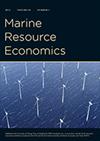Should Fishing Quotas Be Measured in Terms of Numbers?
IF 1.7
3区 经济学
Q2 ECONOMICS
引用次数: 3
Abstract
Whereas rights-based catch regulations such as individual transferable quotas (ITQs) are gaining traction as the key management instrument in many fisheries, most fisheries are additionally regulated by gear restrictions, minimum landing sizes, and similar measures that intend to protect young fish from being caught. Here we study the incentives to fish selectively in a second-best setting, where the regulator issues quotas of different types and fishers choose the size of the fish they catch. We find that if quotas are specified in terms of the number of fish, rather than biomass or weight, fishers have substantial incentives to target larger fish. Thus juvenile fish are protected without need for gear restrictions. We develop the economic principles in an analytical model and quantify results for empirical examples. We find that steady-state profits under second-best deregulated number quota management are only 0.1%–2.1% below the first-best optimum.捕鱼配额应该用数字来衡量吗?
虽然个人可转让配额(itq)等基于权利的捕捞法规作为许多渔场的关键管理工具越来越受欢迎,但大多数渔场还受到渔具限制、最小登陆面积和旨在保护幼鱼不被捕捞的类似措施的管制。在这里,我们研究了在次优情况下选择性捕鱼的动机,在这种情况下,监管者发布不同类型的配额,渔民选择他们捕获的鱼的大小。我们发现,如果配额是根据鱼的数量而不是生物量或重量来规定的,渔民就会有很大的动机去捕捞更大的鱼。因此幼鱼不需要渔具限制而受到保护。我们在分析模型中发展经济原理,并为实证例子量化结果。我们发现,在次优的解除管制数量配额管理下,稳态利润仅比第一优的利润低0.1%-2.1%。
本文章由计算机程序翻译,如有差异,请以英文原文为准。
求助全文
约1分钟内获得全文
求助全文
来源期刊

Marine Resource Economics
农林科学-渔业
CiteScore
4.30
自引率
10.30%
发文量
25
审稿时长
>12 weeks
期刊介绍:
Marine Resource Economics (MRE) publishes creative and scholarly economic analyses of a range of issues related to natural resource use in the global marine environment. The scope of the journal includes conceptual and empirical investigations aimed at addressing real-world oceans and coastal policy problems. Examples include studies of fisheries, aquaculture, seafood marketing and trade, marine biodiversity, marine and coastal recreation, marine pollution, offshore oil and gas, seabed mining, renewable ocean energy sources, marine transportation, coastal land use and climate adaptation, and management of estuaries and watersheds.
 求助内容:
求助内容: 应助结果提醒方式:
应助结果提醒方式:


